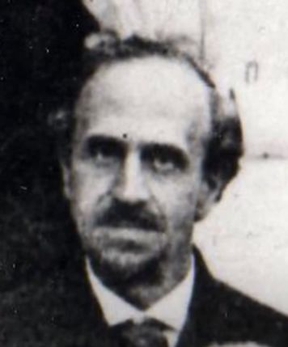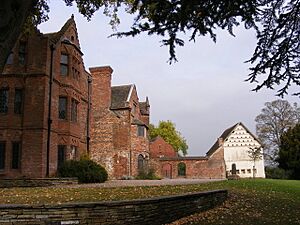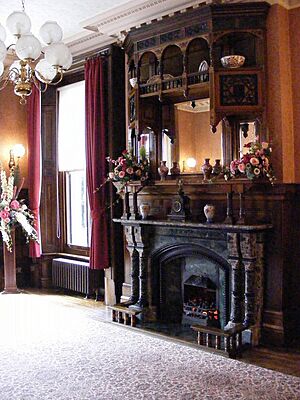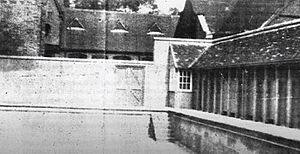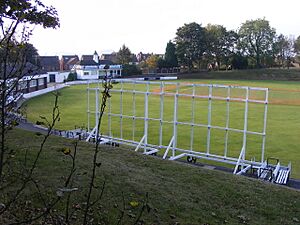Haden Hill Park facts for kids
Quick facts for kids Haden Hill Park |
|
|---|---|

Haden Hill House and Hall, at the North of the park
|
|
| Type | Public park |
| Location | Sandwell, West Midlands |
| Created | 1922 |
| Operated by | Sandwell Metropolitan Borough Council |
| Open | all year |
Haden Hill Park is a lovely public park located in the West Midlands, England. It sits between the towns of Halesowen and Old Hill. Inside the park, you'll find two historic buildings: the old Haden Hall, which dates back to the 1600s, and the beautiful Victorian Haden Hill House. There's also a special area called Corngreaves Nature Reserve. Sandwell Metropolitan Borough Council owns and takes care of the park and its buildings.
The land for the park was owned by the Haden family for many centuries. In 1877, it was passed down to George Alfred Haden Haden-Best. He built Haden Hill House and made the parkland what it is today. In 1922, local people raised money to buy the estate, and it became a public park for everyone to enjoy.
Between 2000 and 2007, the park went through a big makeover, mostly paid for by the National Lottery. Since 2004, Haden Hill Park has won a Green Flag Award every year. This award shows it's a well-managed and welcoming green space. It's also recognized as a Green Heritage Site. Sandwell Council considers Haden Hill Park one of its top nine parks.
Contents
Discovering Haden Hill Park's Past
Early Days of Haden Hill Park
The Haden family lived on the land where the park is now, possibly as far back as the 1200s. They were farmers who became quite successful in the 1600s and 1700s. Their main home was Haden Hall, which was a large farmhouse that grew bigger over time. Most of it was built in the 1600s.
The Haden family passed the estate down through generations. Eventually, in 1877, it went to George Alfred Haden Best. He was asked to add "Haden" to his last name, so he became George Alfred Haden Haden-Best.
George Alfred Haden Haden-Best's Time (1877–1921)
George Alfred Haden Haden-Best was born in 1839. When he inherited the Haden Hill estate, he decided to turn the farm into a grand home with beautiful parkland. He tore down a small cottage next to Haden Hall and built a large, modern Victorian house in its place. This new house had cool features like underfloor heating, running water, and gas lighting.
Haden Hall was kept because his aunt, Mary Barrs, lived there. George Haden-Best probably planned to knock down the old Hall later and make his new house even bigger. But his aunt lived until 1904, so his plans never happened.
Besides building the new house, George Haden-Best also designed the park grounds. He created lakes, pretty walking paths, and gardens. The park was planned to show off the nice views of the Clent Hills to the south. It also hid the industrial areas of the Black Country to the north.
Sometimes, George Haden-Best opened the park to the public. In May 1882, visitors could go boating on the lake and explore the warm glasshouses. In July 1884, there was even a flower show with music and snacks!
George Haden-Best was an important person in the community. He helped fund education and taught at the local Sunday School. He never married but adopted two local girls, Emily Bryant and Alice Cockin. He raised them as his own, giving them a good life.
When George Haden-Best passed away in 1921, his nephews inherited the estate. They sold much of the land. This meant George Haden-Best was the only person who ever lived in Haden Hill House as its owner.
Haden Hill Park Becomes Public (1922 to Today)
The Bassano brothers, George Haden-Best's nephews, put the estate up for sale. People in the community raised £8,500 to buy Haden Hill House, Haden Hall, and the parkland. They wanted it to be used by everyone. The local council officially took ownership on October 14, 1922, and the park opened to the public a week later. The council later bought more land, making the park a total of 52 acres.
By 1935, Haden Hall was in bad shape, and the council thought about tearing it down. But money was raised from both private and public sources to fix it. The Hall was restored by October 1937. It was used as a tea room and for wedding parties. During World War II, part of the Hall even became a safe place for children who had to leave their homes.
After World War II, keeping the park in good condition wasn't a top priority. By 1971, Haden Hill House needed repairs, and Haden Hall was falling apart again. People formed the Haden Hill Preservation Society to save it. In September 1977, a big fire badly damaged the Hall. Sandwell Council couldn't afford the repairs but didn't want to demolish it because of its history.
The Victorian house was repaired over several years and opened to the public in April 1990. A plan to fix and rebuild Haden Hall started in 1990, but it was slow due to lack of money. This changed in 1998 when the National Lottery Heritage Fund gave £2.15 million to make the park new again. The project brought the Hall back to life and improved the gardens, bringing back many of George Haden-Best's original designs. The work was finished in 2007 and was a big success.
Haden Hill was the first park in Sandwell to receive the Green Flag status, showing how special it is.
Exploring Haden Hill Park Today
Park Layout and Features
The park is shaped a bit like a crescent moon. The main parkland stretches from the two historic houses in the north down to the boating lake in the south. The Corngreaves Nature Reserve extends west from the south of the parkland. The River Stour runs along much of the reserve's southern edge, with a wide path next to it.
Haden Hall
Haden Hall is very close to the Victorian Haden Hill House. It's sometimes called the 'Tudor Hall,' but it's not actually from the Tudor period, and it wasn't a grand manor house. It was likely built around the late 1600s as the home of the Haden family. They were becoming wealthier and more important at that time. Over the years, the Hall was changed and rebuilt many times. Today, it looks much like the building that stood there before.
Next to the Hall, there's a brick dovecote that might be from the 1600s. It's connected to the Hall by a wall.
Haden Hill House
George Alfred Haden Haden-Best started building his new house in 1877, and he probably moved in by 1879. The house had at least five bedrooms and a large area for servants. George Haden-Best had planned to knock down Haden Hall and make his new house even bigger, but this never happened.
On the north side of the house, there was a separate group of buildings. These included a carriage house, a harness room, stables for horses, a cow shed, and places for washing and storing coal. On the west side of the old duck pond, there were special glasshouses for growing grapes, peaches, ferns, and palms. A special building with boilers provided heat for these glasshouses.
Today, Haden Hill House is open to the public all year. You can take guided tours to see inside. The house also hosts plays, workshops, and dances. You can see real Victorian furniture and musical instruments on display.
Park Grounds and Gardens
In front of Haden Hall, you can see a piece of an old sandstone cross. It's probably from the Middle Ages. It used to be in Old Hill and was moved to the park in 1937. In the middle of the park, there's a natural 'bowl' of open grass. In George Haden-Best's time, this area was used for making hay. It also used to have a bandstand and a football field.
Along a path below Haden Hill House, there are two small monuments where family pets are buried. One grave is for three cats, and the other is for a dog. There's also a special ditch called a Ha ha that used to separate the gardens from the farmland. It was removed in the 1960s but was put back during the big park restoration project.
A pond has been on the west side of the house since before George Haden-Best's time. It has been changed several times and was fixed up with a feeding platform during the restoration. At the south end of the park, George Haden-Best built a large pool called the Boating Lake. It had a boat house and two rustic bridges. The boat house and one bridge are gone, but the other bridge was rebuilt in 2002. Near the Boating Lake, you can find the last bit of a small, quiet retreat called a hermitage that George Haden-Best built.
Corngreaves Nature Reserve
After the Corngreaves Golf Course closed in 1999, many trees were planted to create a nature reserve. This beautiful area is now part of Haden Hill Park.
Gallery
What Used to Be Here
In July 1926, an outdoor swimming pool was opened in the park. It was 75 feet long and 30 feet wide, but it wasn't heated! It closed in 1966, and there's no sign of it today.
On a slope below the houses, there was a building called the Sons of Rest. This was a place where retired men could meet and relax. The building opened in 1937 but was destroyed by fire in 2000.
A bandstand was put in the grassy bowl area when the park became public in 1922. It was very popular in the 1920s, with weekly concerts in the summer. The bandstand was rebuilt in 1938 but was removed in 1967.
Besides the Boating Lake, George Haden-Best also built three smaller pools higher up in the park. These pools fed water to the Boating Lake through small waterfalls. These smaller pools have now been filled in.
Fun Events and Activities from the Past
In September 1891, a newspaper reported that a jumper named Joseph Darby set a new record for a backward jump at a Haden Hill Park event. He jumped 12 feet 11 inches!
In June 1929, school children had open-air classes in the park. They learned about topics like "Clothing and the Seasons" and "Exercise and Health."
The park used to have two football fields. One was in the grassy bowl, made in 1949, and another in a 9-acre field, opened in 1953. Both were gone by the 1970s. In the 1970s, the park even hosted whippet racing, a traditional sport in the Black Country.
In July 1987, the park hosted Cradley Heath's second annual carnival. It had fun attractions like a fair and a display about World War II.
Corngreaves Golf Course
In 1977, a nine-hole golf course was built next to the park. It was later expanded to an eighteen-hole course. The course closed in 1999. The land was then planted with trees and turned into a nature reserve, becoming part of Haden Hill Park.
Places Near Haden Hill Park
Haden Hill Leisure Centre
In 1976, a modern leisure centre was built north of Haden Hill House. This centre hosted the 1981 John Courage English Professional Snooker Championship.
Old Hill Cricket Club and Old Hill Tennis Club
To the northwest of the park are the grounds for Old Hill Cricket Club and the courts for Old Hill Tennis Club. These areas were once owned by George Haden-Best. Old Hill Cricket Club is very successful, winning national championships several times. Many international players have played there.


